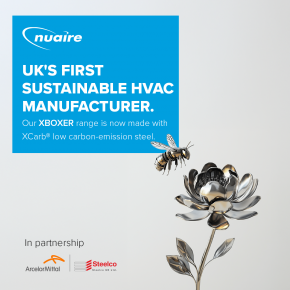
GUEST ARTICLE: Cool buildings for the future
This guest article sees Shaun Hurworth, Channel Manager at Glen Dimplex Heating & Ventilation, look at how buildings can be prepared for the future in terms of space cooling.
“The demand for space cooling is growing rapidly worldwide. The International Panel on Climate Change (IPCC) estimates that the demand for residential space cooling is likely to increase more than ten times by 2050.
If buildings are to be suitable for the future, they will need to take this into account. But how can this be done in a cost and energy efficient way?
One of the last considerations when cooling a building should be application of the cooling technology. This sounds counterintuitive, but makes sense when you consider the contribution that insulation, glazing, ventilation, and heating and hot water play on the amount of cooling that will be required.
Understanding the combined effect of these systems on the temperature of the building can significantly reduce the energy that will ultimately be needed to cool it.
One example of this consideration can be seen in the specification of HVAC solutions in high rise apartment developments.
Traditional systems can dissipate a significant amount of energy into a building’s communal spaces, affecting the need for cooling in the apartments and increasing the energy needed to maintain a comfortable temperature.
An emerging approach is the application of a low temperature network combined with air source heat pumps in the apartments. This low energy loop is able to produce the heating and hot water requirements of the resident locally.
The Zeroth Energy System uses this principal to reduce the network losses of the heating and hot water system that can lead to a building overheating.
The heat pumps can also deliver comfort cooling, but, it is applied after the reduction of potential sources of overheating, meaning that the energy consumed achieving this function is reduced.
Conclusion
As global temperatures rise, building insulation levels increase and the ‘heat island’ effect drives summertime city temperatures higher, the need to keep buildings cool will become a growing priority for design engineers.
The natural reaction is to assess how we can better cool these spaces, however choosing a HVAC solution that minimises the requirement for cooling first will make the specification of cooling simpler, and the impact of its application more energy efficient and cost effective.
Latest news

29th April 2025
WindowBASE launches new prospect databases at FIT Show
Visit WindowBASE at the FIT Show to see first-hand how it helps companies find new customers – the company is launching an easy-to-use, intuitive platform on Stand G16 at the NEC Birmingham from 29th April – 1st May.
Posted in Articles, Building Industry Events, Building Industry News, Building Products & Structures, Building Services, Doors, Exhibitions and Conferences, Glass, Glazing, Information Technology, Innovations & New Products, Posts, Publications, Research & Materials Testing, Restoration & Refurbishment, Retrofit & Renovation, Windows
28th April 2025
Nuaire first UK ventilation manufacturer to use low carbon-emissions recycled & renewably produced steel
Nuaire has announced that its Magnelis® steel based ventilations systems are now being made from XCarb® recycled and renewably produced steel.
Posted in Air Conditioning, Articles, Building Industry News, Building Products & Structures, Building Services, Building Systems, Heating, Ventilation and Air Conditioning - HVAC, Restoration & Refurbishment, Retrofit & Renovation, Steel and Structural Frames, Sustainability & Energy Efficiency, Waste Management & Recycling
28th April 2025
Renderplas: Builders avoid costly remedial work with PVCu render beads
A pioneer of PVCu render beads, Renderplas is helping the construction industry avoid the costly remedial work associated with rusting steel designs…
Posted in Articles, Building Industry News, Building Products & Structures, Building Services, Building Systems, Facades, Posts, Render, Restoration & Refurbishment, Retrofit & Renovation, Sustainability & Energy Efficiency, Walls
28th April 2025
How Celotex’s Technical Team adds value through expert insulation support
From U-value calculations to real-world installation support, Celotex’s technical team helps construction professionals specify and install insulation with confidence…
Posted in Articles, Building Industry News, Building Products & Structures, Building Services, Insulation, Research & Materials Testing, Restoration & Refurbishment, Retrofit & Renovation, Sustainability & Energy Efficiency, Walls
 Sign up:
Sign up: